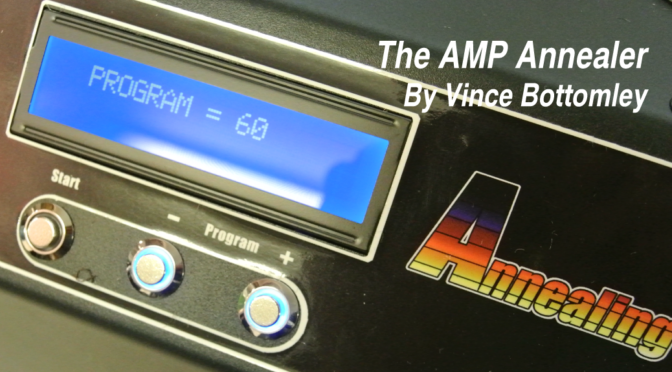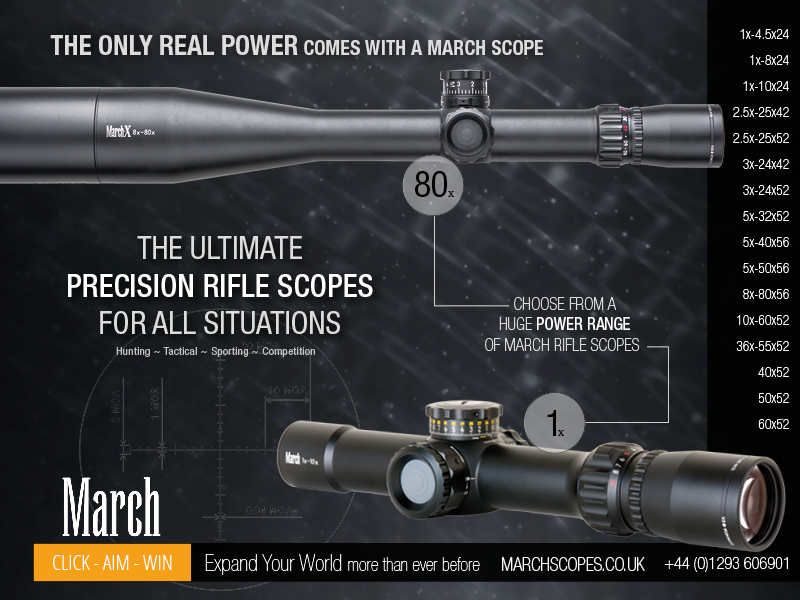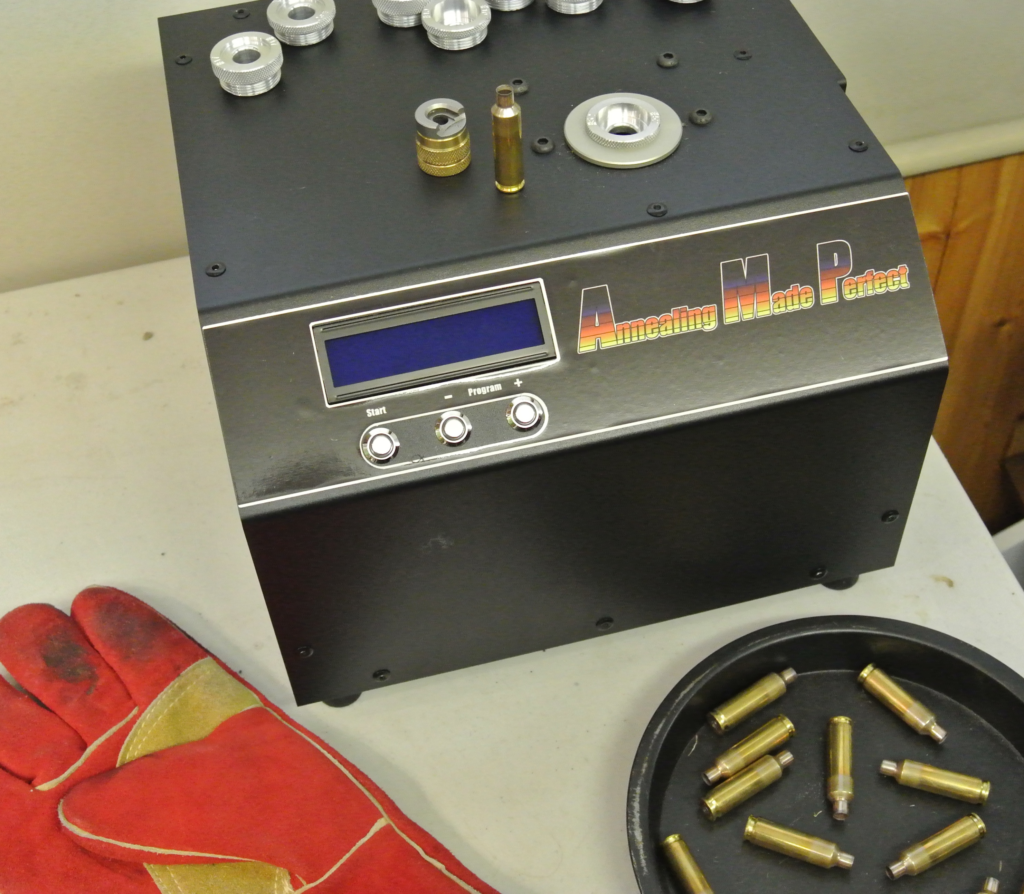
Right off, I’ll admit that although I’m an advocate of the annealing process, I’ve never annealed any of my brass. OK – I did try it about 20 years ago but quickly abandoned it after seriously blowing a primer! Way back then, it was a matter of heating the case to cherry-red with a blow-torch in a darkened room and then dropping it in a bucket of water. We’ve learned a lot since then……
AMP? Although amp or ampere is of course a unit of electrical current, in this case ‘AMP’ is an acronym for Annealing Made Perfect but, as the name suggests, we are annealing with electricity. No blow-torches here!
If you are skeptical about the value of annealing, you might like to read a fascinating treatise published on the internet recently where a British university student chose the subject of brass cartridge-case annealing and its affect on accuracy for his degree dissertation. It was very thorough (49 pages) and revealed some interesting points. It confirmed my belief that once a cartridge case has been fired around five times, the grain structure of the brass changes – with results that we are all too familiar with if we continue to reload it – it gets springy, it work-hardens, neck-tension varies and it becomes prone to splitting. The bolt becomes stiffer to operate and, more importantly, accuracy inevitably suffers.
Accuracy is all about consistency and, when the brass cartridge-case is the only component that we re-use – over and over – we cannot deny the value of annealing as a way of returning the case to something approaching its original condition.
The annealing process involves heating the neck and shoulder area of the case to a certain critical temperature then allowing it to cool. Below this critical temperature, the brass will not recover, above it and the grain structure can alter and weaken the brass. Accurate temperature control is essential and this is where the blow-torch annealers come unstuck. The machines I’ve seen appear to work quite well but, at best, are a bit hit and miss to say the least and rely on the judgement of the operator to some extent. I was not impressed sufficiently to part with my money!
The technical bit
As soon as you have a look at the AMP website www.ampannealing.com and click onto the ‘settings’ menu you begin to realise that this annealing thing is a bit more involved than we thought. The first thing that grabbed my attention was the annealing schedule for the 308Win case. There are no less than 23 different 308 cases listed from different manufacturers and it turns out that there are 13 different annealing programmes covering these cases.
Reason? Different brands of brass require different power levels. We are only annealing the neck and shoulder and extensive metallurgy tests have revealed that alloy composition is not the reason. Rather it is the mass of brass to be annealed. For example, brands such as Lapua and Norma are usually heavier in the neck and shoulder. There is a significant variation between the requirements of each brand, so settings are individualised for each one.
The AMP annealing schedule lists a whole range of common cartridges and a lot of not so common ones as well – 180 in all and, it’s bang up to date with cartridges like the 6XC, 6.5 Creedmoor, 6.5 Grendel, 300 Blackout plus plenty of classics like 50 BMG, 45-70, 303 British, 30-06, 30-30, 308 and a whole host of wildcats like the Dasher, 6-6.5×47 Lapua, 6-284, 284 Shehane, 7-300 WSM, 30BR etc. etc. but more on that later.
How does neck-turning influence the process? As brass is removed, the mass in the air gap reduces, meaning that less power is required. AMP provide separate settings not just for standard brass but for neck turnings of – 0.001”, – 0.002” and – 0.003”. If requested, they will add settings for further turning reductions.
Clearly, it is most important to enter the correct setting. Brass with say 0.003” turned off the neck will be overheated if the ‘standard’ setting is used. Standard settings list the nominal neck-wall thickness of each cartridge they calibrate. This is an average of six readings per case x 4 cases. When you are assessing your own neck-turned brass please use a proper tube micrometer – do not rely vernier calipers to measure your neck-wall thickness. It may give a false thickness dimension – use a proper tube mike to ensure best annealing results.
Suddenly, the blow-torch, stopwatch and Tempilaq starts to look just a bit hit ‘n’ miss don’t you think – especially if accuracy is important to you as brass-life.
But what if, like me, you shoot some weird and wonderful wildcat that isn’t included in the extensive list of cartridges? No problem – AMP are happy to work out a programme especially for YOU! I sent off six of my fired, neck-turned 6mm Smack cases and a couple of weeks later I got a nice e-mail giving me my very own programme and now, me and my Smack are on the official ‘settings’ list. It doesn’t get better than that! The Smack by the way is an ‘improved’ version of the Lapua 6-6.5×47 (which is already listed) but the programmes are quite different.
Here’s how we anneal with the AMP
So, let’s get the AMP out of the box and do some annealing. The black metal box gives little clue to the innards and workings. All we can see is a screen, three buttons and a hole in the top where the case is inserted.
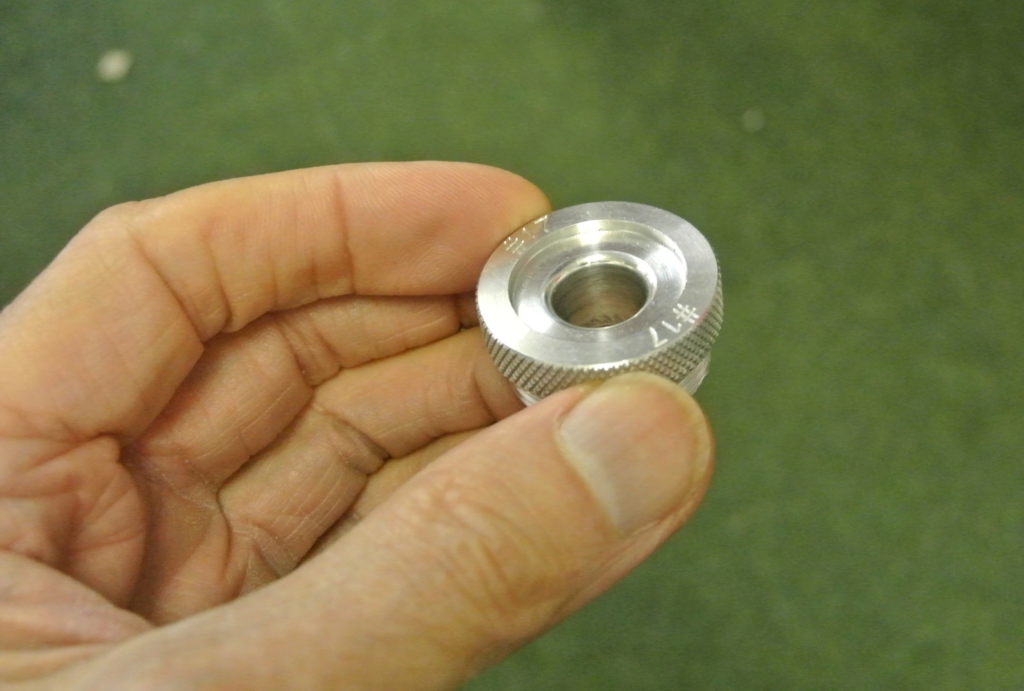
Let’s look at this hole first. The hole is threaded to take ‘pilots’. These pilots control the depth of the cartridge case in relation to the heat-supplying induction coil. In other words, they are critical to the process. We have purchased a range of pilots and we can cover most of the popular cases that shooters are likely to encounter. For home use, two or three pilots might do. They are not expensive anyway.

So, with the appropriate pilot screwed into the hole, we are almost ready to anneal. The cartridge-case is held in a conventional shell-holder – just like the one in your reloading press – which in turn is clamped in a brass holder – allowing you to handle the cases without burning your fingers as you remove the hot case. Have a look at the pic – it should make sense.
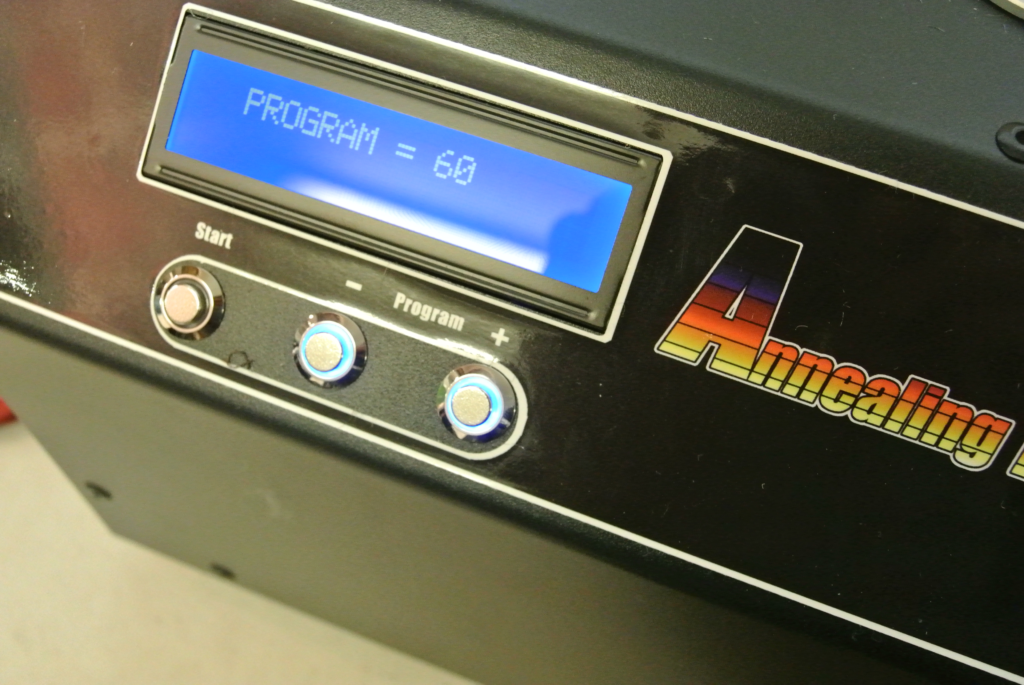
Now, consult the ‘settings’ chart for the unique prog. for your particular case and input the number – using buttons and screen – and we are ready to go. Insert the case, press the start button, a red light glows for a few seconds, goes out and you’re done. Remove the case and let it fall from the holder into a suitable metal tray to cool.
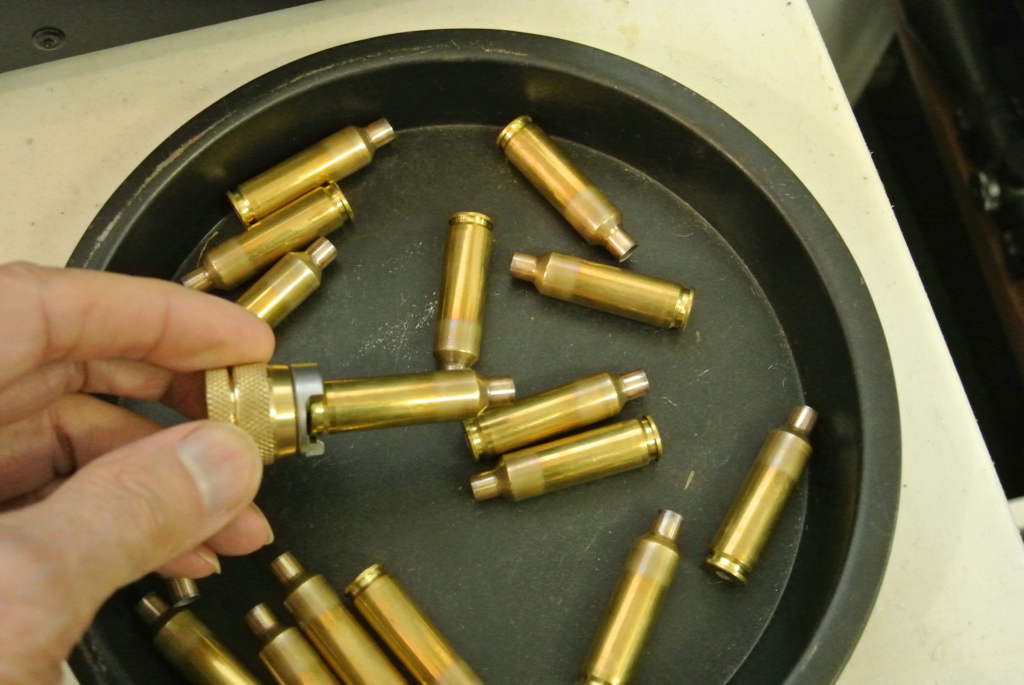
You’ll probably run a box of fifty through in under 10 minutes. Before you start, it’s best to clean the outside of the neck with Duraglit wadding or similar and a quick scrub inside – which you hopefully do anyway as part of your reloading process.
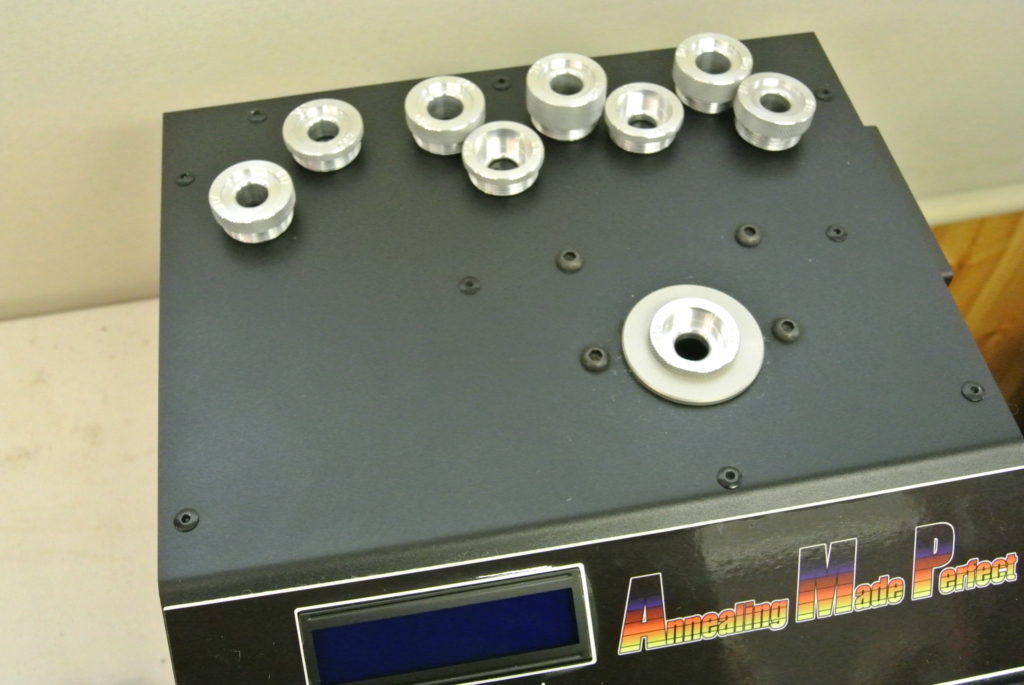
The benefits of annealing
So, what happens next? Well the first thing you will notice is the ease of full-length resizing. With old springy brass you may have to exert a firm pull on the press-handle but, once annnealed – easy peasy! Similarly, when you chamber a round, the bolt will close ‘knife through butter’ on the soft brass. You may even want to back off your re-size die a tad! Unfortunately however, annealing won’t help those slack primer-pockets………
But, here’s what you all want to know – does the annealed brass shoot better than old work-hardened brass? Honestly, I haven’t tested side by side at the moment but I intend to – so watch this space. I have noticed however, when shooting over the chrono, that velocity spreads are certainly down and that’s got to make a difference at long-range.
For me however, the AMP has been a revelation – I shoot a lot of wildcat cartridges and, with lengthy case-forming procedures with rounds like the Dasher, it was always painful to ‘retire’ brass after half a dozen firings. Now, all that old brass is being brought out of retirement – thanks to the AMP!
So, what’s not to like about the AMP annealer? In a word – nothing! Yes, it’s expensive at over a grand but three of us have formed a consortium, so we each only paid about the same price as a typical blowtorch machine. It’s very portable and so far, joint ownership is working well – it’s not the kind of thing you are using 24/7 and we’ve pulled a bit of cash back by letting other club members anneal their brass after a shoot for 10p per case.
The machine is made in New Zealand and March Scopes UK are the European distributor and they have a stock of machines on the shelf, if you suddenly get the urge to rejuvenate your brass, you can e-mail info@marchscopes.co.uk

